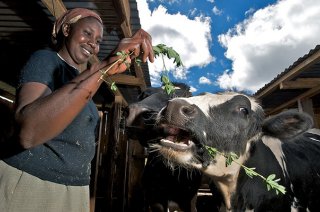
Project
A local to global study of climate-smart livestock in Kenya (PhD project - Rachel Gitundu)
The implicit interconnectedness of sustainable development goals (SDGs), creating either synergies or trade-offs, calls for collaboration among various stakeholders. This means deliberative and collective action amongst relevant governmental agencies, businesses, Civil society organizations (CSOs), and developmental agencies for effective implementation. Since these stakeholders have different institutional backgrounds, resources, interests and stakes, power asymmetries are inevitable. Poorly managed, power asymmetries could undermine the potential of such collaborations. This project investigates the role of power in collaborations among public and private stakeholders of the Kenyan dairy sector and how these impact interactions between SDG2, SDG13, SDG10 and SDG5 among dairy producers.
Background
Dairy is central to food security in Kenya and an important contributor to the gross domestic product. The sector is also a big emitter of greenhouse gases, contributing 64-78% of emissions. The government sets policy objectives to increase production through intensification and commercialization as a means of ensuring food security (SDG2) and growing the sector. However, the benefits of intensification and commercialization are often unequally distributed with poorer households and women being less well positioned to reap them. This creates an adverse relationship with reduced inequalities (SDG 10) and Gender equality (SDG 5). Unguided, growth of the dairy sector has the potential of increasing livestock sector emissions and the number of livestock at-risk from climate change impacts. In addition to government efforts, the dairy sector attracts a lot of private sector investments from dairy processors, cooperatives, feed suppliers and even financial institutions. Several international programmes and projects with varied donors are also implemented at both National and sub-national levels. Since this role of steering dairy development in the country spreads across state and non-state actors. Deliberations and collective action amongst the relevant governmental agencies, businesses, CSOs, and developmental agencies is required.
Description
The SDG framework promotes the interconnectedness and indivisibility of the goals, in that targets of one SDG may overlap, reinforce, or contradict the targets of one or several others. When progress in one goal favors progress in one or multiple other goals, a synergy is created. However, in situations where progress in one goal hinders progress in others, this undesirable effect is called a trade-off.
The SDG framework thus encourages different stakeholders to work together for inclusive and effective implementation of the 2030 agenda. How this can be actualized is however still largely problematic undermining the achievement of the agenda by 2030. This is given that resources and responsibilities for different SDGs and SDG targets are fragmented across sectors and levels.
To contribute to finding solutions to this onerous governance challenge, this project begins from the local to the global level to answer the question; what role does power play in collaborations among public and private stakeholders of the Kenyan dairy sector and how does this impact interactions between SDG2, SDG13, SDG10 and SDG5?
The project will begin with qualitatively generating empirical evidence of SDGs interactions in the day-to-day lives of dairy producers. Subsequently, it will assess collaboration or non-collaboration among business stakeholders, CSOs, governmental agencies, and their donors. Finally, an analysis of how direct and indirect power strategies influence these processes will be done to establish ways in which different power sources and strategies could be leveraged to address trade-offs and build synergies for inclusive and effective SDG implementation.
The project takes an intersectional approach to SDG interactions and analyzes multi-stakeholder collaborations using the power in and power over framework.

